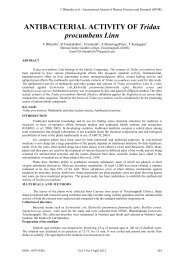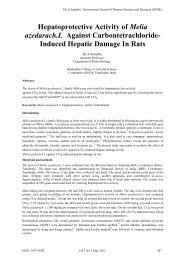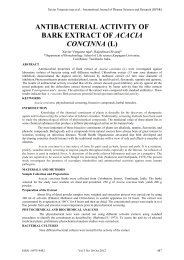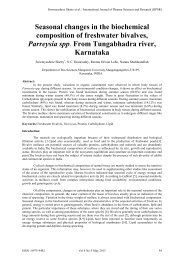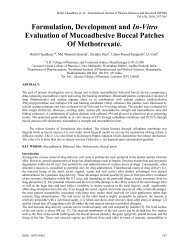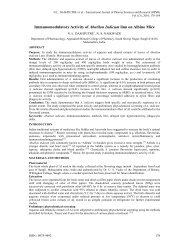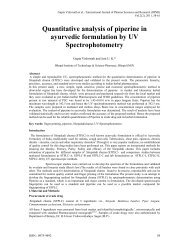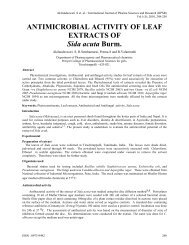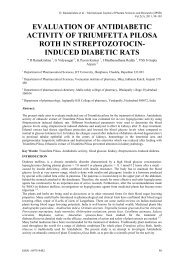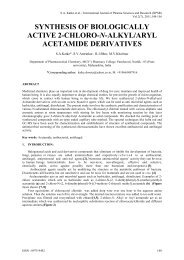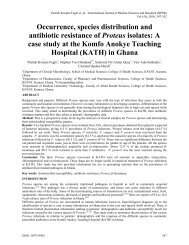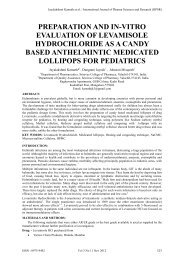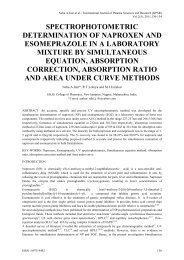antimicrobial activity of pericarp extract of garcinia mangostana linn.
antimicrobial activity of pericarp extract of garcinia mangostana linn.
antimicrobial activity of pericarp extract of garcinia mangostana linn.
You also want an ePaper? Increase the reach of your titles
YUMPU automatically turns print PDFs into web optimized ePapers that Google loves.
Protocols for anti-bacterial <strong>activity</strong>:<br />
Vishnu Priya et. al. / International Journal <strong>of</strong> Pharma Sciences and Research (IJPSR)<br />
Vol.1(8), 2010, 278-281<br />
6 mg <strong>of</strong> the <strong>extract</strong> was mixed with 300 micro lit <strong>of</strong> DMSO so as to get a concentration <strong>of</strong> 20 micro gm in 1 micro lit<br />
<strong>of</strong> the suspension. 5ul, 10ul, 15ul, 20ul and 25ul volume <strong>of</strong> <strong>extract</strong> was loaded on to sterile discs corresponding to<br />
the concentrations as shown in the Table - I.<br />
Table – I: IT SHOWS THE LOADING OF THE EXTRACT ON TO THE STERILE DISCS.<br />
Volume Concentration <strong>of</strong> <strong>extract</strong><br />
5µl 100µg<br />
10 µl 200µg<br />
15 µl 300µg<br />
20 µl 400µg<br />
25 µl 500µg<br />
The herbal <strong>extract</strong> in different concentration (above mentioned) was tested against Staphylococcus aureus, S. albus<br />
and Micrococci for antibacterial <strong>activity</strong> separately. After 24 hours incubation period the plates were observed and<br />
the inhibition-zone was recorded as given in the Table - II.<br />
TABLE – II: IT SHOWS THE RECORDING OF THE INHIBITION ZONE AFTER THE INCUBATION PERIOD.<br />
Strain<br />
Staphylococcus<br />
aureus<br />
Staphylococcus<br />
albus<br />
Micrococci<br />
Concentration <strong>of</strong> <strong>extract</strong><br />
100 µg 200 µg 300 µg 400 µg 500 µg<br />
8mm 8mm 9mm 10mm 12mm<br />
9mm 10mm 12mm 13mm 17mm<br />
8mm 9mm 10mm 11mm 14mm<br />
MINIMAL INHIBITORY CONCENTRATION (MIC):<br />
A serial 2-fold broth dilution method was performed to determine the MICs <strong>of</strong> herbal <strong>extract</strong>s against bacterial<br />
strains. Stationary-phase cultures <strong>of</strong> all strains were prepared by inoculating fresh broth tubes and incubating at<br />
37°C till 0.5 Mc Farlands standard was achieved. Serial 2-fold dilutions were prepared from <strong>extract</strong> stock solutions<br />
and 1.0 mL <strong>of</strong> each standardized bacterial suspension was added to an equal volume <strong>of</strong> each <strong>extract</strong> dilution. After<br />
incubation for 24 h ± 1 h at 37 ° C, turbidity <strong>of</strong> the cultures was assessed visually by comparison to uninoculated<br />
controls. The MIC was defined as the lowest concentration <strong>of</strong> <strong>extract</strong> where bacterial growth was not detected. The<br />
MICs were determined from independent triplicate assays and were based on a serial 2-fold dilution starting with the<br />
initial concentration <strong>of</strong> 400 µg / ml.<br />
ISSN : 0975-9492 279



